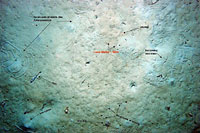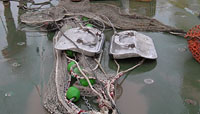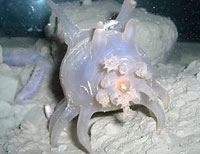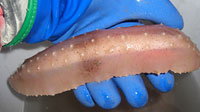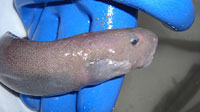

 | |||||||||||||||||||||||||||||||
|
|
Journals 2008/2009Roy Arezzo
July 24, 2008 I was up on watch a little early to catch the images from another successful deployment of the Yoyo Camera. Although the data from the images has not yet been analyzed, we observed a flat bottom coated with the fresh sediment we have been collecting. The images turned up ample evidence of many invertebrates from burrow patterns, fecal signatures and live animals. When you sit with the scientists and look at the sediment they paint a vivid picture of the recent history of activity showing how the animals interact with the sediment. Hard bottoms tend not to leave evidence of who has occupied the area but soft sediment reads like a history book, illustrating the use and transfer of nutrients.
Today, I learned that we have an Otter Trawl onboard when the chief scientist decided it was time to use it. With a wider mouth than our Blake Trawl, the Otter Trawl is capable of netting a broader sample of the fauna; however, the Blake Trawl tends to be a tougher net for surveying the bottom. Equipped with a metal sled and stronger mesh, the Blake Trawl does well against stones from glacial fall out that are common at the more southern sites and has been the "go-to" net throughout the study. Station AA has fewer rocks, according to previous surveys, and with a smooth flat bottom we are able to use the Otter Trawl with little risk of damage. For Stations AA and B we will compare results of both trawl nets.
Craig, who likes to work the trawls regardless of time of day, always shows enthusiasm for everything that comes up in net from the smallest creature to the most common stone. He explained to me why the stones on the Antarctic seafloor have sharper edges than rocks from other continental shelves. The sharp edges demonstrate evidence of a glacial migration; a trip preserved in ice causes less scouring and weathering than the eroded materials that typically make their way from land to sea. "Drop-stones" are uncommon in sediment plains at the margins of other continents. The randomness of where stones have been dropped makes sampling the bottom here a challenge.
Station AA revealed notable contrasts from our trip south to the ice. Many of the sediment feeders we are interested in were present, but there was some variation in the species we brought up. Most obvious to me is the absence of many Protelpidia murrayi (sea pigs) and other thin skined holothurians. The sea cucumbers here tend to be large, thick-skinned species, like Bathyplotes. Also, we are seeing more coral, sea urchins, octopi, fish and larger sea stars.
Megafauna from Station AA:
The day was filled with Megacore activity and I found myself out on deck often. The seas have picked up occasionally washing over the deck, necessitating that we be more diligent when we tend the tag lines to stabilize the instruments from swinging out of control during deployment. Fortunately, Jack our senior MT, always shares a daily safety tip in exchange for my signature on his mandated paperwork to keep me thinking straight on deck. |
||||||||||||||||||||||||||||||
